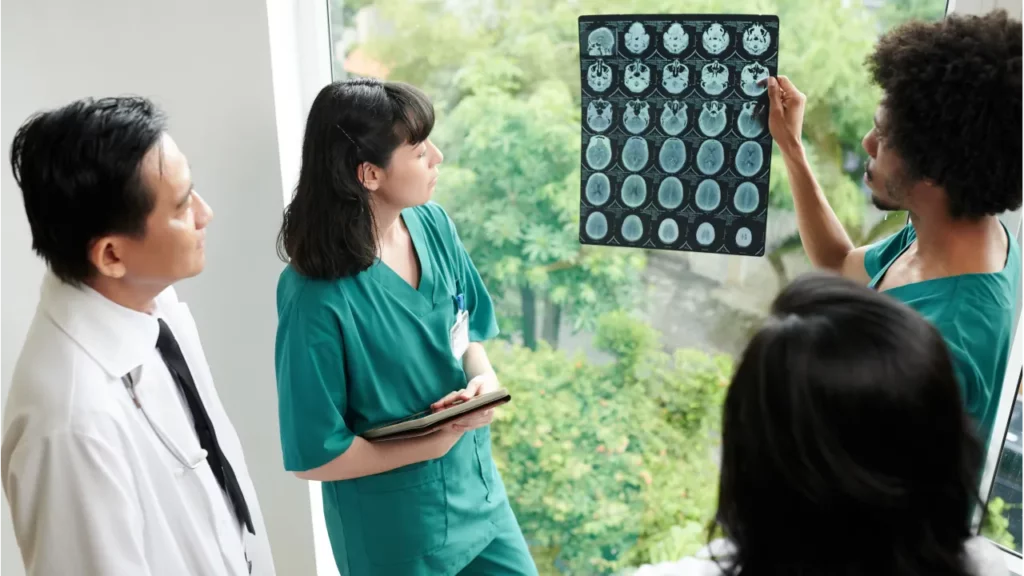Disclaimer: The information provided in this article is for educational purposes only and should not be construed as medical advice. Individuals experiencing symptoms should consult with a qualified healthcare professional for accurate diagnosis and appropriate treatment options.
Normal Pressure Hydrocephalus (NPH) and Idiopathic Intracranial Hypertension (IIH) are complex neurological conditions with distinct characteristics, affecting the brain’s fluid dynamics and intracranial pressure regulation. While they share some similarities, such as presenting with cognitive and visual symptoms, understanding their unique features is crucial for accurate diagnosis and tailored management.
Differentiating between NPH and IIH is paramount for healthcare professionals to provide optimal care and improve patient outcomes. Misdiagnosis or delayed diagnosis can lead to ineffective treatments and potential complications, underscoring the critical need for precise differentiation through comprehensive evaluation and specialized testing. Moreover, advancements in healthcare technology, such as remote patient monitoring, offer additional tools for continuous assessment and management of these conditions, enhancing the overall quality of care.
Understanding Normal Pressure Hydrocephalus (NPH) and Idiopathic Intracranial Hypertension (IIH)
| Features | Normal Pressure Hydrocephalus (NPH) | Idiopathic Intracranial Hypertension (IIH) |
|---|---|---|
| Definition and background | NPH is characterized by the abnormal accumulation of cerebrospinal fluid (CSF) within the brain’s ventricles, resulting in ventricular enlargement and increased intracranial pressure. This condition primarily affects older adults and is often associated with comorbidities such as vascular disease or prior brain injury, contributing to its complexity. | IIH, also known as pseudotumor cerebri, is characterized by elevated intracranial pressure without an identifiable cause, predominantly affecting younger, obese women. Despite its designation as “idiopathic,” IIH is associated with various risk factors and comorbidities, highlighting the complexity of its pathogenesis and clinical presentation. |
| Causes and risk factors | The exact etiology of NPH remains elusive, although advancing age and certain medical conditions are recognized as predisposing factors. Additionally, prior brain trauma, subarachnoid hemorrhage, or meningitis may contribute to the development of NPH, highlighting the multifactorial nature of this condition and its diverse risk factors. | The underlying mechanisms of IIH remain poorly understood, although obesity is a significant risk factor, likely contributing to altered CSF dynamics and intracranial pressure regulation. Other potential risk factors include certain medications, hormonal imbalances, and genetic predisposition, underscoring the multifactorial nature of IIH and its heterogeneous presentation. |
| Symptoms and clinical presentation | NPH typically presents with a triad of symptoms: cognitive impairment, gait disturbances, and urinary incontinence, collectively impacting an individual’s functional independence and quality of life. These symptoms often manifest insidiously and progress gradually, necessitating vigilance in clinical assessment and symptom monitoring. | IIH commonly presents with severe headaches, visual disturbances, and pulsatile tinnitus, reflecting the neuro-ophthalmic manifestations of increased intracranial pressure. These symptoms can significantly impair visual function and quality of life, necessitating prompt evaluation and management to prevent long-term complications. |
| Diagnostic methods | Diagnosing NPH requires a comprehensive approach, including clinical evaluation, neuroimaging studies, and specialized tests such as lumbar puncture to measure CSF pressure. Neurologists and neurosurgeons collaborate closely to differentiate NPH from other neurodegenerative disorders with overlapping clinical presentations, ensuring accurate diagnosis and appropriate management. | Diagnosing IIH involves clinical assessment, neuroimaging studies, and specialized tests such as fundoscopic examination to assess for papilledema. Differential diagnosis is essential to rule out secondary causes of intracranial hypertension and guide appropriate management strategies tailored to individual patient needs. |
| Treatment options | The primary treatment for NPH is surgical intervention, typically involving CSF shunt placement to divert excess fluid and alleviate symptoms. However, patient selection for surgery is critical, considering individual factors and potential risks. Conservative management approaches, including physical therapy and supportive care, are also integral components of NPH management for patients with milder symptoms or contraindications to surgery. | Treatment for IIH focuses on reducing intracranial pressure and alleviating associated symptoms. This may include lifestyle modifications, such as weight management and dietary changes, pharmacotherapy with diuretics or acetazolamide, and surgical interventions such as optic nerve sheath fenestration or CSF diversion procedures for refractory cases. |
Comparing and Contrasting NPH and IIH
Understanding the nuances between Normal Pressure Hydrocephalus (NPH) and Idiopathic Intracranial Hypertension (IIH) is crucial for accurate diagnosis and tailored management. Below are the differences, variations and challenges related to these two conditions.
Pathophysiological differences
While both NPH and IIH involve disturbances in CSF dynamics and intracranial pressure regulation, they differ in their underlying pathophysiology. NPH is characterized by ventricular enlargement due to CSF accumulation, whereas IIH presents with elevated pressure without ventricular enlargement, reflecting distinct etiological mechanisms.
Clinical presentation variations
Although NPH and IIH may share some symptoms, such as headaches and visual disturbances, they also exhibit unique clinical features. NPH is characterized by the triad of cognitive impairment, gait disturbances, and urinary incontinence, whereas IIH predominantly presents with headaches and visual symptoms, highlighting differences in symptomatology and disease progression.
Diagnostic challenges
Distinguishing between NPH and IIH can be challenging due to overlapping symptoms and diagnostic criteria, necessitating a comprehensive evaluation by a multidisciplinary team. Specialized tests, including neuroimaging studies and CSF analysis, are essential to differentiate between these conditions and guide appropriate management strategies tailored to individual patient needs.
Management Approaches
Implementing effective management strategies is essential for addressing the complex nature of Normal Pressure Hydrocephalus (NPH) and Idiopathic Intracranial Hypertension (IIH), aiming to alleviate symptoms and improve patient outcomes.
Medical management strategies
Medical management of NPH and IIH may include pharmacotherapy to reduce intracranial pressure and alleviate associated symptoms. This may involve the use of diuretics, acetazolamide, or other medications to modulate CSF dynamics and improve clinical outcomes, complementing surgical interventions when indicated.
Surgical interventions
Surgical interventions play a crucial role in the management of NPH and IIH, particularly in refractory cases or when conservative measures fail to adequately control symptoms. For NPH, shunt surgery is the primary surgical intervention, whereas IIH may require optic nerve sheath fenestration or CSF diversion procedures to alleviate intracranial pressure and prevent vision loss.
Prognosis and Long-term Outlook
Understanding the prognosis and long-term outlook of Normal Pressure Hydrocephalus (NPH) and Idiopathic Intracranial Hypertension (IIH) is essential for guiding treatment decisions and optimizing patient care.
Impact on quality of life
Both NPH and IIH can significantly impact an individual’s quality of life, leading to cognitive decline, mobility impairment, and visual disturbances. Timely diagnosis and appropriate management are crucial to mitigate long-term complications and optimize functional outcomes, emphasizing the importance of ongoing monitoring and supportive care.
Potential complications
Untreated or inadequately managed NPH and IIH can lead to progressive neurological decline, vision loss, and decreased independence, highlighting the need for comprehensive management and long-term follow-up. Multidisciplinary care and patient education are essential to address potential complications and optimize patient outcomes in the context of these complex neurological disorders.
Research and Advancements
Ongoing research endeavors are pushing the boundaries of our understanding regarding the pathophysiology, diagnosis, and treatment options for Normal Pressure Hydrocephalus (NPH) and Idiopathic Intracranial Hypertension (IIH), leading to promising advancements in the field of neurology and neurosurgery.

Current Studies and Findings
Pathophysiological insights: Ongoing research efforts aim to advance our understanding of NPH and IIH pathophysiology and identify novel diagnostic tools and therapeutic interventions.
Diagnostic innovations: Emerging research findings hold promise for improving diagnostic accuracy, treatment efficacy, and patient outcomes, driving innovation and progress in the field of neurology and neurosurgery.
Genetic and biomarker exploration: Recent studies have also explored the role of genetic predisposition and biomarkers in the development and progression of NPH and IIH, shedding light on potential personalized treatment approaches.
Emerging Therapies
Minimally invasive techniques: Novel therapies, including minimally invasive surgical techniques and targeted pharmacological agents, are being investigated for their potential role in the management of NPH and IIH.
Addressing unmet needs: These emerging therapies represent promising avenues for addressing unmet needs and improving clinical outcomes, underscoring the importance of ongoing research and innovation in the field of neurologic disorders.
Adjunctive modalities: Additionally, non-invasive modalities such as transcranial magnetic stimulation (TMS) and cerebrospinal fluid (CSF) shunting optimization techniques are being explored as adjunctive therapies to conventional treatments, offering new possibilities for symptom management and disease modification.
Frequently Asked Questions (FAQs)
What are the main differences between NPH and IIH?
NPH is characterized by ventricular enlargement due to CSF accumulation, while IIH presents with elevated intracranial pressure without ventricular enlargement.
How are NPH and IIH diagnosed?
Diagnosis involves a comprehensive evaluation, including clinical assessment, neuroimaging studies, and specialized tests to differentiate between the two conditions.
What treatment options are available for NPH and IIH?
Treatment options include surgical interventions, such as shunt surgery or optic nerve sheath fenestration, as well as medical management with medications to alleviate symptoms and reduce intracranial pressure.
Can NPH or IIH be cured completely?
While there is no definitive cure for NPH or IIH, timely diagnosis and appropriate management can help alleviate symptoms and improve functional outcomes.
What lifestyle changes can help manage NPH and IIH?
Lifestyle modifications, including weight management, regular exercise, and stress reduction, can support overall well-being and symptom management in NPH and IIH patients.
Are there any ongoing research efforts for NPH and IIH?
Ongoing research aims to advance our understanding of NPH and IIH pathophysiology and identify novel diagnostic and therapeutic interventions to improve patient outcomes.
Connecting DrKumo RPM Solution to Deciphering the Differences: Normal Pressure Hydrocephalus vs. Idiopathic Intracranial Hypertension
Deciphering the differences between NPH and IIH is crucial for accurate diagnosis and tailored management, especially in the context of disease management programs (DMPs). DrKumo, a leading provider of Connected Health Technology, offers real-time continuous Remote Patient Monitoring (RPM) solutions that can significantly enhance the management of chronic neurological conditions like NPH and IIH. By leveraging DrKumo’s highly secure cybersecurity framework and HIPAA-compliant solutions certified by URAC, healthcare providers can ensure the highest level of security for patient data while effectively monitoring and managing patients with NPH and IIH.
DrKumo’s RPM technologies, powered by state-of-the-art AI-machine learning engines, are scalable and versatile, allowing for seamless integration into various healthcare settings, including chronic care management and hospital care at home. Through its user-friendly interface and continuous real-time monitoring capabilities, DrKumo empowers healthcare providers to make informed decisions and optimize treatment strategies for patients with NPH and IIH, ultimately improving health outcomes and patient satisfaction.
Takeaways
Advancing our knowledge, raising awareness, and fostering collaboration among healthcare providers can improve outcomes and quality of life for NPH and IIH patients. Early detection, prompt treatment, and ongoing research are vital for overcoming the complexities of these disorders and enhancing patient care.
With DrKumo’s advanced RPM technology solutions and commitment to patient-centric care, healthcare providers can optimize treatment strategies, improve health outcomes, and enhance patient satisfaction.
Contact us today to learn more about how DrKumo can support your healthcare practice.











